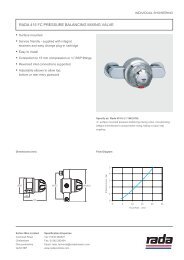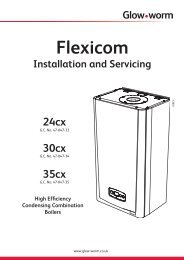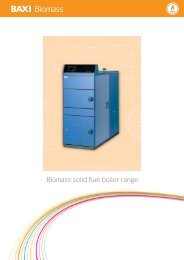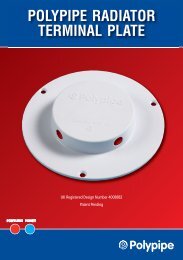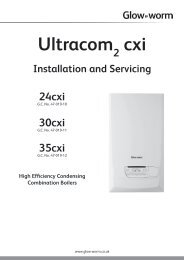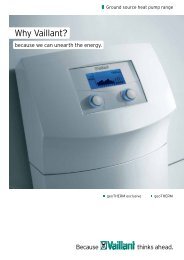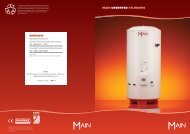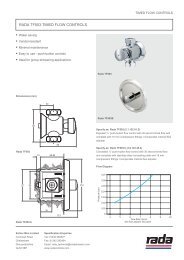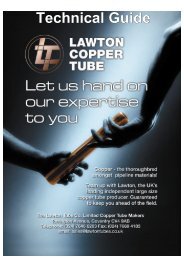Hep20 Technical Handbook
Hep20 Technical Handbook
Hep20 Technical Handbook
You also want an ePaper? Increase the reach of your titles
YUMPU automatically turns print PDFs into web optimized ePapers that Google loves.
Pipes in Concealed<br />
Locations<br />
Hep 2 O ® pipework can easily be<br />
installed in concealed locations in<br />
floors, roof spaces etc. Any<br />
expansion which may occur will<br />
have little mechanical effect, this<br />
being absorbed within the pipe<br />
length as undulation which may be<br />
ignored. Undulation of Hep 2 O ®<br />
pipe which may occur naturally as a<br />
result of expansion, or installation<br />
through joists, will not lead to<br />
airlocks. Installation in difficult<br />
locations is aided by the cabling<br />
ability of Hep 2 O ® pipe. If<br />
adequately supported, Hep 2 O ® in<br />
concealed locations needs only to<br />
be clipped for system alignment e.g.<br />
at changes in direction.<br />
Where convenient, cable ties can be<br />
used to restrain pipes for system<br />
neatness (care should be taken not<br />
to overtighten the tie). The pipe<br />
should be able to slide freely<br />
through the tie to facilitate thermal<br />
movement.<br />
Pipes in Exposed<br />
Locations<br />
Hep 2 O ® pipe expands as<br />
temperature increases causing it to<br />
undulate along its length. This can<br />
be visually unacceptable in the case<br />
of long exposed runs. Long runs of<br />
exposed pipe are unusual in new<br />
build where pipework is generally<br />
concealed, but may occur in<br />
refurbishment.<br />
If the pipework is exposed there are<br />
a number of options open to the<br />
installer to ensure that a neat, tidy<br />
job is achieved:<br />
• Hep 2 O® pipework, if exposed,<br />
can be boxed in (PVC-U trunking<br />
or preformed plywood profiles<br />
are generally used).<br />
• Long runs of exposed Hep 2 O®<br />
may be unsightly as a result of<br />
expansion and therefore the<br />
installer may choose to use<br />
copper pipe in this instance.<br />
Pipes Through Walls and<br />
Floors<br />
Whenever Hep 2 O ® passes through<br />
brickwork, stone or concrete the<br />
pipe should be sleeved. The annular<br />
gap between the pipe and the sleeve<br />
should be filled with a resilient<br />
material to provide effective fire<br />
stopping and prevention of noise<br />
transmission from one room to<br />
another.<br />
Pipes Through, and<br />
Adjacent to, Metalwork<br />
When running Hep 2 O ® adjacent to<br />
or through metalwork, it is<br />
important to ensure that the pipe<br />
cannot make contact with any sharp<br />
edges as this could cause damage<br />
during thermal movement. Any of<br />
the following preventative measures<br />
would be acceptable:<br />
•<br />
For a pipe passing through a<br />
small hole drilled in metalwork,<br />
fix a resilient grommet in hole.<br />
•<br />
For a pipe passing through a large<br />
hole in metalwork or adjacent to<br />
a sharp edge, fix an extruded<br />
flexible profile to metalwork.<br />
• Provide sufficient local pipe<br />
clipping to prevent contact<br />
between pipe and metalwork.<br />
• Run pipe within a conduit.<br />
69



